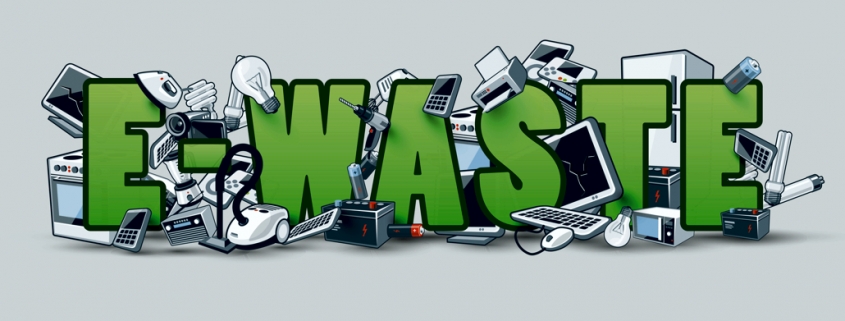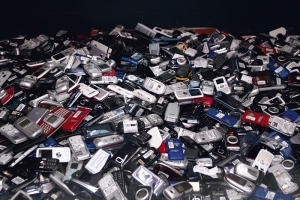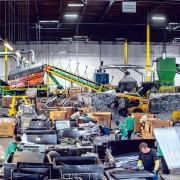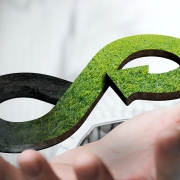The Future for E-Waste Could be Bright
A plea for the circular economy by the E-waste coalition, a group of seven UN entities that have come together to increase cooperation and more efficiently provide support to Member States and Parties to address the e-waste challenge.
According to the report “A New Circular Vision for Electronics – Time for a Global Reboot”, published by the World Economic Forum, a “more circular electronics system, one in which resources are not extracted, used and wasted, but valued and re-used in ways that create decent, sustainable jobs” could generate huge economic benefits. As reported, e-waste is the fastest-growing waste stream in the world. In 2018, it was estimated, that the global “mountain” of this kind of waste reached nearly 50 million tons. Such e-waste is worth at least 62.5 billion US-Dollar annually, the authors of the “Global E-Waste Monitor 2017” had estimated. This amount of money would be “more than the gross domestic product (GDP) of most countries,” the report “A New Circular Vision for Electronics – Time for a Global Reboot” described the economic dimension. “In fact, if e-waste was a single nation, its GDP would be on a par with that of Kenya. Furthermore, 123 countries have less GDP than the global pile of electronic waste,” the report refers to figures of the International Monetary Fund. “In the right hands, however, it could be worth considerably more,” the authors are convinced.
The scale of e-waste
As reported, in 2016 about 44.7 million metric tons of e-waste was generated globally. According to the information, this amount was equivalent to just over six kilograms for every person on the planet.
“One-half of all e-waste is personal devices, such as computers, screens, smartphones, tablets and TVs and the rest is larger household appliances, as well as heating and cooling equipment. The scale of global e-waste defies comparison, yet the weight is more than all the commercial aircraft ever produced,” the authors of “A New Circular Vision for Electronics” vividly depicted the situation. “Imagine the mass of 125,000 jumbo jets – it would take London’s Heathrow Airport up to six months to clear that many aircraft from its runways. If you find that difficult to envisage, then try the mass of 4,500 Eiffel Towers, jam them all in one space, side by side, and they would cover an area the size of Manhattan. Of this total amount, 36 million tons of e-waste are discarded in landfill, 21 burned or illegally traded and treated in a sub-standard way every year.”
By the year 2021, the annual volume of global e-waste is expected to surpass 52 million tons. Estimates by the United Nations University in Vienna indicate that by 2050 the amount could top 120 million tons annually. “According to the Organization for Economic Cooperation and Development (OECD), by 2060, the world’s consumption of raw materials is set to double,” the authors underlined.
Low recycling rates
Recycling rates globally are low. Even in the European Union (EU), which leads the world in e-waste recycling, just 35 percent of e-waste is officially reported as properly collected and recycled. Globally, the average is 20 percent, the authors stated. The remaining 80 percent “is undocumented, with much ending up buried under the ground for centuries as landfill”.
Currently, recycling some types of e-waste and recovering materials and metals is an expensive process, the authors of the report conceded. The remaining mass of e-waste – mainly plastics laced with metals and chemicals – poses a more intractable problem. The waste stream is complex, containing up to 60 elements from the periodic table. In some cases, it contains hazardous chemicals, such as flame-retardants, of which some are Persistent Organic Pollutants listed under the Stockholm Convention. “There is also confusion in global consumers’ minds in terms of how they handle e-waste,” they wrote. “In many cases, it is treated as normal household waste, but it must be separated. Different streams of e-waste must also be dealt with separately, including batteries, light bulbs, smartphones, cables or computers.” This lack of awareness about how to recycle – and worries about data security – would mean there are vast tranches of residual electronics sitting in drawers, garages, bedrooms and offices across the globe waiting to be dealt with. “An opportunity in waiting,” the authors said.
According to the information, in total, 1.3 million tons of discarded electronic products are exported from the EU in an undocumented way every year. “There is a complex web of trans-shipment ports so that e-waste avoids detection by authorities.” At the same time, shipments of secondary materials from consumer countries to centers of production with the intention of re-integrating materials into new products would benefit from clear international definitions on secondary materials, the authors of the report think. Shipments of used products for repair, refurbishment or direct re-use are subject to legislative uncertainties.
Economic value
There is a lot of economic value in e-waste: A ton of smartphones would contain 100 times more gold than a ton of gold ore. “The earth’s richest deposits of valuable materials are sitting in landfill sites or people’s homes. More needs to be made of these resources.” The latest forecasts would show that e-waste is worth more than 62 billion US-Dollar annually – and was worth three times the output of all the world’s silver mines.
An example: In 2017, 1.46 billion smartphones were sold. At retail, each unit contains electrical components worth more than100.49 US-Dollar. If just the raw materials are recycled, they could be worth up to 11.5 billion US-Dollar, the report informed. More effective use of products would be a second life, which keeps the materials at a higher value; corresponding markets were well developed.
In 2016 alone, 435,000 tons of phones were discarded, despite containing billions of dollars’ worth of materials. “To capture this opportunity, it will be important to move towards a circular economy for electronics.”
The economic benefits of employing a circular economic model in the electronics and electrical sector could be enormous, according to the report. “Since e-waste is a growing resource and given resource scarcity and price fluctuations for some metals and minerals on the horizon, there is a growing economic case for the recovery of these precious resources. This, combined with better designs and technology for resource recovery, will produce more profitable yields of materials, reinforcing the case.”
If developed in the right way, “employing a circular economy for the electronics and e-waste sector could create millions of jobs worldwide,” the authors are convinced. “Some may be in low-paid and low-skilled work as more e-waste is reclaimed into the system, but over time, this will change with a wide range of job opportunities emerging. This will give rise to the need, for instance, new designers, circular economists and urban mine specialists and EaaS (electronics as a service) officers. The future is bright.”
_____________________
Collaboration wanted
This report combines data and research from throughout the UN system to make the case for a new vision, the representatives of the different entities, which form the “E-waste Coalition”*), stated in the foreword. Describing and analyzing challenges and opportunities, and laying the groundwork for the process of systemic change is just the first step, they admitted. To make a circular economy for e-waste happen, in their opinion, the following conditions are required:
■ “Vision: Society needs to collectively rethink the rules of the game and create a vision around which government, consumers and industry can rally.
■ Awareness: The public needs to learn more about this growing global challenge and opportunity.
■ Collaboration: This coalition seeks to work with multinationals, small and medium-sized enterprises (SMEs), entrepreneurs, employers’ associations, academia, trade unions, civil society and associations in a specific and deliberative process to bring about change. Public-private collaborations through platforms such as PACE (Platform for Accelerating the Circular Economy) and the E-waste Coalition will play an important role.
■ Action: Coordinated action by all actors is needed within and across national borders.”
*) The coalition brings together: the International Labour Organization (ILO); the International Telecommunication Union (ITU); the United Nations Environment Programme (UNEP); the United Nations Industrial Development Organization (UNIDO); the United Nations Institute for Training and Research (UNITAR); the United Nations University (UNU) and the Secretariat of the Basel and Stockholm Conventions.
_____________________
Photo: petovarga/stock.adobe.com
(GR 22019, Page 28)










